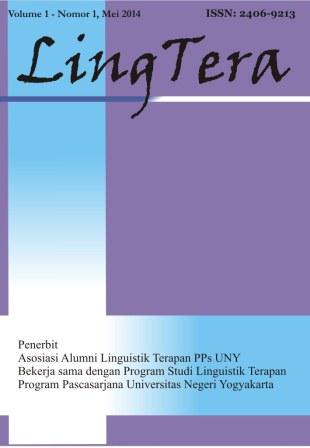Phonological errors in the pronunciation of Indonesian nasal consonants by native Arabic speakers
DOI:
https://doi.org/10.21831/lt.v12i1.78968Keywords:
pronunciation errors, native Arabic speakers, Indonesian, distinctive phonological features, phonology, nasal consonantsAbstract
This descriptive qualitative study investigates pronunciation errors in Indonesian nasal consonants made by native Arabic speakers. Using a reading elicitation technique, data were collected focusing on the pronunciation of the nasal consonants /ŋ/ and /ɲ/, which were then transcribed using International Phonetic Alphabet (IPA) symbols. The analysis involved identifying distinctive features of sounds within the nasal segment when errors occurred. The results revealed a consistent pattern of assimilation, with changes notably influenced by surrounding sounds. Velar nasals underwent assimilation influenced by both vowels and consonants, resulting in substitutions such as /ʔ/, /ɢ/, and /n/. In contrast, palatal nasals showed assimilation primarily influenced by adjacent vowels, leading to alterations represented by /ʔ/ and /ɲj/. These findings highlight the systematic nature of phonological errors in the pronunciation of nasal consonants by Arabic speakers learning Indonesian and offer valuable insights for language instructors and researchers in the field of second language acquisition.
References
He, L. (2022). An analysis of nasal production of Chinese learners of English in Wu Chinese dialect area. In Proceedings of the 2022 8th International Conference on Humanities and Social Science Research (ICHSSR 2022) (pp. 2510–2513).
Jahara, S. F., & Abdelrady, A. H. (2021). Pronunciation problems encountered by EFL learners: An empirical study. Arab World English Journal, 12(4), 194–212. https://doi.org/10.24093/awej/vol12no4.14
Kim, C.-W. (1977). Rule ordering in Korean phonology (Vol. 1). Korean Studies. https://about.jstor.org/terms
Lathifah, N. R., Anggita, F. D., & Rosianingsih, S. (2021). Analisis kesalahan berbahasa dalam tataran fonologi pada kanal YouTube “Mas Bas-Bule Prancis.” Lingua Rima: Jurnal Pendidikan Bahasa dan Sastra Indonesia, 10(1), 91. https://doi.org/10.31000/lgrm.v10i1.4094
Mahmood, A., Irfan, H., Alfares, N. S., & Yasmeen, S. (2023). Pronunciation of English velar nasal (angma) by undergraduate students in Pakistani universities. Studies in English Language and Education, 10(3), 1167–1180. https://doi.org/10.24815/siele.v10i3.31073
Nawari, A. (2019). Analisis pelafalan bunyi bahasa Indonesia oleh penutur bahasa Arab di Universitas Sousse, Tunisia. Balai Bahasa Riau.
Nurman, M. (2021). The correlation between phonological knowledge and pronunciation ability. Journal of English Education and Teaching (JEET), 5(2), 290–302.
Owens, J. (2013). The Oxford handbook of Arabic linguistics (J. Owens, Ed.). https://doi.org/10.1093/oxfordhb/9780199764136.013.0001
Rafkahanun, R. (2021). Analisis kesalahan fonologis dalam keterampilan berbicara pembelajar BIPA di Pusat Studi Indonesia Ismailia Mesir. Madah: Jurnal Bahasa dan Sastra, 12(1), 78–87. https://doi.org/10.31503/madah.v12i1.380
Rehman, I., Silpachai, A., Levis, J., Zhao, G., & Gutierrez-Osuna, R. (2022). The English pronunciation of Arabic speakers: A data-driven approach to segmental error identification. Language Teaching Research, 26(6), 1055–1081. https://doi.org/10.1177/1362168820931888
Safitri, I., Putri, A. P. H., & Nur Sahadati, D. M. (2020). Analisis kesalahan berbahasa dalam tataran fonologi pada kanal YouTube “Net Drama.” Cakrawala Indonesia, 5(2), 25–34. https://doi.org/10.55678/jci.v5i2.447
Salameh, M. Y. A. B. (2021). Phonemic consonant sounds in Modern Standard Arabic. Linguistics and Culture Review, 5(S2), 1643–1658. https://doi.org/10.21744/lingcure.v5ns2.2257
Sokhey, N. (2021). Auditory and acoustic evidence for palatalization of the nasal consonant in Cairene Arabic. Languages, 6(4). https://doi.org/10.3390/languages6040190
Yang, J. H. (2007). The role of sound change in the speech recognition system: A phonetic analysis of the final nasal shift in Mandarin. ROCLING/IJCLCLP.
Yeaqub, M. (2018). Similarities and dissimilarities of English and Arabic alphabets in phonetic and phonology: A comparative study. Al-Arabi: Jurnal Bahasa Arab dan Pengajarannya, 2(2), 94–105. https://doi.org/10.17977/um056v2i2p94-105
Yenti, D., & Rofiq, I. R. R. (2022). Elicitation techniques in turn-taking practices in EFL classroom interaction. International Journal of Pedagogical Novelty, 1(1), 25–29.
Yoviyani, S. H., & Mulyati, Y. (2023). Menyibak sistem fonetik bahasa Indonesia dan bahasa Arab serta implikasinya dalam pembelajaran BIPA. Jurnal Onoma: Pendidikan, Bahasa, dan Sastra, 9(2), 1012–1022. https://doi.org/10.30605/onoma.v9i2.2838
Downloads
Published
How to Cite
Issue
Section
Citation Check
License
Copyright (c) 2025 Nurul Hasana, Agus Subiyanto

This work is licensed under a Creative Commons Attribution-ShareAlike 4.0 International License.
LingTera allows readers to read, download, copy, distribute, print, search, or link to its articles' full texts and allows readers to use them for any other lawful purpose. The journal allows the author(s) to hold the copyright without restrictions. Finally, the journal allows the author(s) to retain publishing rights without restrictions.
- Authors are allowed to archive their submitted articles in an open-access repository.
- Authors are allowed to archive the final published article in an open-access repository with an acknowledgment of its initial publication in this journal.

Psychology, Evaluation, and Technology in Educational Research is licensed under a Creative Commons Attribution-ShareAlike 4.0 International License.
Based on a work at https://petier.org/index.php/PETIER.









